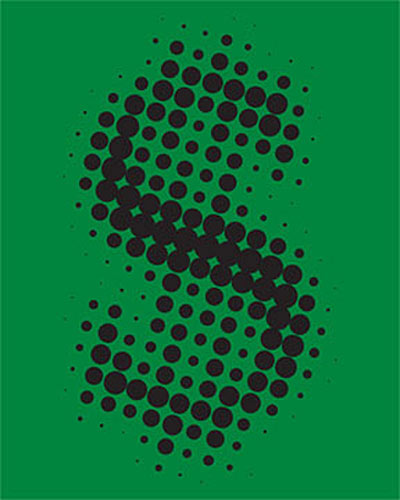
The corporate infiltration on every aspect of culture has become commonplace. One can rarely walk down the street without adverts slipping into view. Galleries, museums, and non-profits that make up much of the art world can’t function without solid financial partners from the corporate world, where their presence is felt on title walls and printed media. However the commercial realities of art galleries and museums become troublesome when politics are identified and trends established that demonstrate the individuals running these arts institutions are not acting with the highest moral authority. It’s not as though the art world is an innocent victim of corporate sponsorship. Both the art institution and the corporate sponsor have something to gain from such a relationship. Ryan McGinness takes pleasure in this context by showcasing these backroom dealings in his current exhibition.
McGinness first explored the concept of sponsorship locally in 2003 at BLK/MRKT Gallery [in Culver City, now defunct—Ed.] with an exhibition that consisted entirely of logos from corporate sponsors who supported the exhibition. Absolutely no artwork was made for the show. Instead, company logos like Levi’s, OBEY, and Scion were reproduced based upon the amount they contributed. Larger contributions equated to a greater presence in the gallery. The show was organized in a professional manner and the logos became the art, or rather stood in the place of art. This was not an attempt to highlight design, it was a glimpse at the underbelly of sponsorship, which leaves the viewer empty in the end. But it was a clever visual acknowledgement of the gallery and sponsor’s dependence upon one another. However, the show also left much to be desired in terms of the artist’s role in this process, an issue that McGinness now appears interested in redressing.
The exhibition, titled “SponsorshipREDUX,” is billed as a follow-up to the first. Ironically this exhibit is being held at a gallery space co-founded by Shepard Fairey, one of the original sponsors (OBEY) of the first show. The criticism that McGinness offers therefore is not biting and cynical but perhaps more of an alliance that is out in the open, as though there may be many levels of sponsorship beyond the white walls of the gallery to make a show like this possible.
McGinness released a call to corporations this year inviting participation in the second incarnation of this show. In the release he clearly lays out exactly what he intends to do with the logos. Rather than simply display them, McGinness formally deconstructs the logos and use these disassembled bits and pieces to create paintings and prints. He agreed not to stretch, distort, or change the proportions of the logos but simply cut them up, recombine them, and concentrate on organizing large abstract forms. The logos are still recognizable but they will have the mark of the artist through acrylic paint. Companies like Reebok, incase, and Zevia all felt motivated to participate based upon the description.
Brand identity is certainly a major aspect of marketing. However, the presence of the artist in this relationship has the potential to both strengthen these goals and complicate them. McGinness is actually creating something based upon the support he is given (sponsorship as a medium). Sponsors are therefore banking on the artist’s creativity to benefit their brand. But it could just as easily backfire. The logos do not look exactly as they should and this can be a problem from the standpoint of branding. But they are involved in a creative context, a win for trendy companies looking to impress more creative audiences. But seeing this experiment as more than an artistic NASCAR painting is the downside.
McGinness promises to align the participating companies with a gallery and artist that are defining culture, shaping the mainstream for years to come, and an opportunity to build loyalty among an influential audience. Initially the concept of creating a show about the financial structures that support arts institutions is illuminating and worthy of discussion. In essence it’s a show about nothing that highlights a behind the scenes glimpse. However, McGinness’ influence is extending far beyond Subliminal Projects, since this show appears to be the underbelly of six additional exhibitions held all over Los Angeles this during the months of May and June. Within a larger scope of works unrelated to this series, the emptiness of this set of paintings appears quite sharp and brave, and could be viewed as the financial scaffolding that made the others possible.
Published courtesy or ArtSceneCal ©2011
